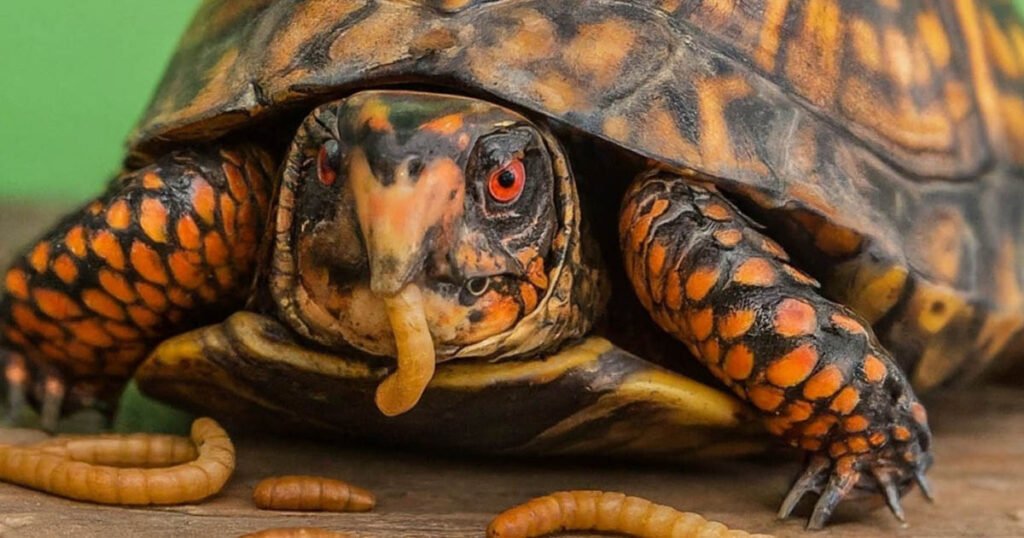Turtles are omnivores, which means they can have a varied diet, including meat, vegetables, and fruits. They savor different types of lively insects. So, this information naturally raises the question, “Can turtles eat mealworms?” Besides many other insects, turtles can eat mealworms.
Turtles, known for their diverse appetites, may have varied preferences when it comes to mealworms. From red-eared sliders to box turtles, different turtle species may have different reactions to this particular treat.
In this beginner-friendly guide, we’ll explore the question, “Can turtles eat mealworms?”. If you’re starting with turtles or a seasoned owner, this article will give you insight into whether mealworms suit them.
Can Turtles Eat Mealworms?

Yes, turtles can eat mealworms. Mealworms are the larval form of the Darkling Beetle, and they are commonly used as a protein source in turtle diets. However, mealworms should not be the only food for turtles. They should be fed occasionally, as they are high in protein and fat.
It’s important to provide a balanced diet for turtles, including vegetables, fruits, and other protein sources. You should consider the specific dietary needs of your turtle species when feeding them mealworms.
What Are Mealworms?
As we mentioned above, mealworms are the larval stage of the Darkling Beetle. They are commonly used as food for pets like turtles. Mealworms offer essential nutrients like protein.
Types of mealworms:
1. Live Mealworms: These are active and move around, stimulating natural hunting instincts in turtles. Live mealworms are typically the most preferred option, offering enrichment and mental stimulation.
2. Dried Mealworms: Dried mealworms are convenient and have a longer shelf life than live ones. They retain most of their nutritional value and are suitable for turtles that may not prefer live prey.
3. Freeze-Dried Mealworms: Freeze-dried mealworms are similar to dried ones but have undergone a freeze-drying process to preserve nutrients. They are lightweight, easy to store, and can be rehydrated if necessary. These are a good option for turtles with specific dietary requirements or owners looking for a convenient feeding option.
Mealworms Body Components
Mealworms are about 70% water, providing essential hydration. They contain 3% carbohydrates, 20% proteins, and around 5% fat. They also provide vitamins and minerals vital for turtle health.
Nutritional Benefits of Mealworms for Turtles

Mealworms are a nutritious addition to a turtle’s diet, providing essential nutrients for their health.
Protein Content: Mealworms are rich in protein, which supports turtles’ muscle growth and development and aids overall strength and vitality.
Essential Amino Acids: Mealworms contain essential amino acids for turtles’ bodily functions, contributing to their overall well-being.
Fats: Mealworms are high in fats, and they provide essential fatty acids necessary for energy and cellular function in turtles.
Caloric and Protein Content: A serving of 100 grams of mealworms contains approximately 206 calories and 14-15 grams of protein, providing a significant nutritional boost for turtles.
Fiber: Mealworms contain fiber, aiding digestion and promoting a healthy digestive system in turtles.
Minerals: Mealworms are a source of essential minerals like phosphorus and magnesium, supporting various physiological processes in turtles.
Risks of Overfeeding Mealworms for Turtles
Naturally, adding mealworms to your diet is safe. However, feeding too many mealworms or solely relying on them can lead to health issues due to their high-fat content.
Pyramiding Concerns: If your turtle eats a lot of mealworms packed with protein, its shell might start growing strangely, affecting its overall well-being. This condition is called pyramiding, and it is responsible for the turtle’s discomfort.
Addiction Risk: Turtles might get too used to eating mealworms and reject other foods, which could make them miss out on essential nutrients.
Nutritional deficiencies: A diet solely made of mealworms can result in calcium deficiency, which can lead to metabolic bone disease in turtles.
Obesity and Stunted Growth: Overfeeding mealworms can cause obesity and hinder growth due to their high fat and calorie content.
Sodium Content: Turtles can have kidney issues if they rely on this food too much. So, avoid mealworm diets daily due to their high sodium content.
Before incorporating mealworms into a turtle’s diet, consult a veterinarian for personalized advice.
What Type Of Turtle Eats Mealworms?

Turtles are omnivores, which means they eat both plants and meat. Different species have unique dietary requirements based on their natural habitats and lifestyles.
Aquatic Turtles
Aquatic turtles, such as red-eared sliders, need a diet rich in aquatic plants and animals. While they can eat mealworms, they should only be a small part of their diet. Like,
Box turtles are omnivores and enjoy a diverse diet, including insects and worms like mealworms, which provide essential protein.
Land Turtles and Tortoises
Primarily herbivorous, some land turtles, like the Russian tortoise, can occasionally consume mealworms. However, due to their slow metabolism, it’s important to feed in moderation.
What’s The Right Amount of Mealworms to Feed Your Turtle?
You have to find the right balance when feeding turtle mealworms. It’s recommended that you feed your turtle mealworms once or twice a week, rather than every day, to maintain a balanced diet.
Consider your turtle’s size, age, and overall health when deciding how many mealworms to give them. Mix up their diet with other nutritious foods to ensure they get all the nutrients they need. Overfeeding can lead to health issues, so it must be moderate.
Can Baby Turtles Eat Mealworms?
Yes, baby turtles can eat mealworms without any risk. But it’s essential to balance mealworms with other foods. You can serve small mealworms to ensure the baby turtle’s eating safety.
Baby turtles have unique nutritional requirements, so providing a diverse diet that includes commercially produced and fresh foods, including veggies and fruits, is vital. However, baby turtles love meat diets more than herbivores.
FAQ
Can box turtles eat mealworms?
Yes, box turtles can indeed eat mealworms! They provide essential protein and vital nutrients like potassium, iron, and zinc, which help keep their shells healthy. However, you must be mindful of their slower metabolism, as overfeeding mealworms can cause digestive problems.
Can musk turtles eat mealworms?
Yes, Musk turtles can enjoy mealworms as an occasional treat, but they shouldn’t rely on them as their main meal. Since Musk turtles like carnivorous food, mealworms are a tasty snack, but they keep their fat levels in check while serving too much protein.
Can turtles eat dried mealworms?
Turtles can definitely munch on dried mealworms. Even though they may not seem as fresh as live ones, dried mealworms still offer the essential nutrients turtles need. For your turtle’s health, make sure you pick additive-free dried mealworms.
Can turtles eat live mealworms?
Yes, turtles can eat live mealworms, which offer the most nutrition. Live mealworms provide essential nutrients like protein, fat, and iron. Turtles enjoy the taste and texture of mealworms. However, it’s best to limit them due to their waste production and low calcium content.
Can eared slider turtles eat mealworms?
Yes, red-eared slider turtles can enjoy both live and dried mealworms. However, feeding live mealworms in balance is essential due to potential digestion issues. Dried mealworms are a safer choice, being easier to digest and less likely to cause problems.
Read More: Can Turtles Eat Bell Peppers?
Bottom Line
Overall, the answer to “Can Turtles Eat Mealworms” is positive. There are several types of mealworms, and all of them are absolutely safe for most turtle species. Although you must remember that mealworms are mainly protein sources, turtles should have them in a balanced quantity with other food categories.
